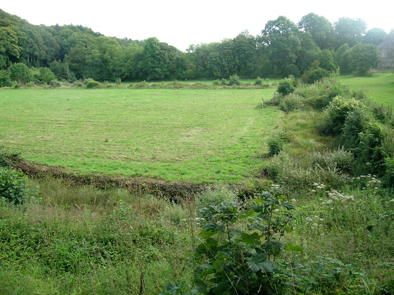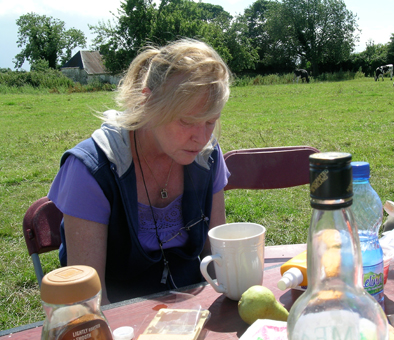Filed under: Uncategorized
Niall Martin of RTÉ produced a fantastic short documentary on the field school. It went out on Sunday 23 August 2009 on Nationwide. The programme can be accessed on the RTÉ website.
http://www.rte.ie/news/2009/0823/nationwide.html
Filed under: Uncategorized
Joanna Leigh has produced very exciting results from her geophysical survey. We have plenty of features to investigate in the next season.

Results of the geophysical survey.
Filed under: Uncategorized
Co-Directors Matthew and Geraldine Stout had a holiday in Brittany and were able to take in a few cistercian abbeys on the way. At Abbeye du Relec they saw small Medieval enclosed gardens. These were remarkably like the small fields at Bective detected in the topographical survey.

Small Medieval enclosed gardens at Abbeye du Relec

A footbridge across the moated enclosed gardens at Abbaye du Relec.
Filed under: Uncategorized
The Irish Times reported the following on 4 August 2009.
Dig reveals secrets of ‘green’ monks
AN ARCHAEOLOGICAL dig has unearthed evidence about a monastic order with a “green agenda” in medieval Co Meath, where a group of monks dependent on handouts battled to become self-sufficient. Over the past month, a large team of archaeologists and volunteers has helped uncover the secrets of one of Ireland’s oldest abbeys. The dig, which finished last Friday at the Cistercian Bective Abbey in Co Meath, was led by husband and wife archaeological team Matthew and Geraldine Stout, from St Patrick’s College Drumcondra and the Archaeological Survey of Ireland respectively, and assisted by over 30 volunteers. Dr Geraldine Stout said the Cistercians had brought a “green agenda” to Ireland. “They were the first monastic order to become self-sufficient. Until then, monasteries had been dependent on receiving food as gifts from local lords. The Cistercians at Bective Abbey were far more sustainable, as they farmed 4,000 acres of land, processed their own corn and began a programme of land reclamation.” The dig began on July 6th with a blessing and turning of the sod by Abbot Father Augustine McGregor, the Cistercian Abbot of the larger Mellifont monastery, a predecessor of whom founded Bective over 800 years earlier. Bective Abbey, founded in 1147, is the oldest Cistercian foundation in Co Meath and the second-oldest Cistercian foundation in Ireland. The importance of Bective is indicated by the fact that it was chosen to hold the remains of Hugh De Lacy, who had been made Lord of Meath by Henry II. The abbey at Bective was dissolved in 1536. Dr Stout said that the dig had been a huge success, and pointed to the discovery of a deep medieval defensive ditch and a 13th-century building, believed to have been a guesthouse, as the most exciting finds. “We’re delighted. We’ve only sampled quite a small area so to find the guesthouse we were extremely lucky. We’ve been able to identify it as a guesthouse, because of the waste we’ve found in a drain that was against the wall,” she said. “It was full of a range of animal bones and oyster shells, which would have been for guests, rather than the monks, who only ate fish.” Dr Stout said the dig was helping to uncover the details of the daily lives of the monks. “This is what I’m interested in – the daily life of how the monks ate and worked, not just the spiritual side of the monastery. It’s like painting a picture and gradually bringing more detail into it. Obviously, the more detail we put in, the better we can understand medieval life.” About half of the volunteers are trainee archaeologists from the Irish Archaeological Field School, which is run by CRDS Ltd, an independent historical consultancy company that has sponsored the dig this year. The students have been supervised by the Stouts, who have over 30 years of archaeological experience, and a number of younger professional archaeologists, who have been “working on the front-line of archaeology in the past few years”. One student, John Alannis (23), a third-year archaeology student from Dundrum, said that working at Bective had given him “a practical summation of what can’t be learnt in the classroom. We’ve learnt all of the necessary tactics for an excavation. I’m raring to go again next summer and I’ll be trying to get a few of my classmates to come with me.” Many of the volunteers were locals. Said Dr Stout: “I think it’s so important to link archaeology to the local community, because after all, this is a National Monument, so it belongs to everyone, not just archaeologists.”
Filed under: Uncategorized
Today the cuttings were backfilled under the supervision of Liam and our wagons moved on. The site was left to the cows and peace returned to Bective Abbey.

Site supervisor Liam Chambers, with wheelbarrow, and Richard Reid work around two stone pillars uncovered at the excavation site in front of Bective Abbey, Bective, Co Meath, prior to the backfilling of the cuttings (Photo: Barry Cronin).

The cows enjoy the return peace and quiet to Bective Abbey.
Filed under: Uncategorized

Andrea from Wexford takes a well-earned break from her heroic exertions in the Medieval ditch.

The last man standing … in the medieval ditch, Bernard digs out the last deposits.

Cutting E – The Medieval ditch was bottomed two metres below the sod.

Kevin O'Brien instructs the Field School participants in the ways of architectural survey.

Happy birthday John, happy birthday to you.
Filed under: Uncategorized
On this day the final recording of the post pads in Cutting B took place and the section faces were drawn. Cuttings A and E refuse to bottom out. A medieval ditch (at last) is found in Cutting E, hidden under what we first thought to be the natural subsoil. Brendan (from Trim), Andrea (all the way from Wexford), and George (a guide at Loughcrew) toiled relentlessly through the day to empty the ditch. Meanwhile, Farnan brother and sister, Stephanie, Siobhán, Aine and Liam stepped up the pace in Cutting A.

Distinguished visitors Denis Boyle and Sylvia FitzPatrick from Kilmoon are shown the post-pads by co-director Geraldine Stout.

Farnan brother and sister team at work in Cutting A.

Margaret Williams returned from fieldwork in Greece to help us out.